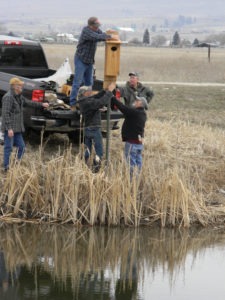
By Michael Howell
If you know a Wood Duck in the Bitterroot Valley who is looking for just the right spot to raise a little brood, but is maybe in too much of hurry or too tired to think of any new excavation and is looking for one of those popular pre-made boxes, you should send her to the Teller Wildlife Refuge. And if she’s tired of the usual, hum drum, plywood construction found in so many other places, she will be thrilled to find the option of some new “deluxe” nesting boxes located next to Thomas Pond.
These new boxes are made of maple and cedar, with large doors for cleaning access, and convenient “ladders” for the hatchlings to use when they make their leap into the world, which is generally not more than a day after hatching. The boxes have drain holes in the bottom. The floor is covered with wood shavings and the female Wood Duck will cover that with a layer of down. No nails or screws were used in the construction of the boxes; the pieces were doweled together. The entrance hole is designed to allow easy entrance for the bird but small enough to keep a raccoon out. The hardwood shines through several coats of oil. They are works of art as well as craft.
The boxes were built by Mark Dickerson. He’s got some interest in Wood Ducks given that he has two degrees in wildlife biology. He’s also got some interest in woodworking, having crafted many wooden tables as housewarming gifts for everyone he has sold a home to in his career in real estate sales. Dickerson made the two boxes that were installed next to Thomas Pond last week and two more that that will be used to replace a couple of older boxes that are going to moved, based on the advice of wildlife biologist Jay Gore, who is helping with the project. Plans call for two more boxes to be placed in the open, slough area on the Refuge, to the east of where 15 nesting boxes are currently located between Gird Creek and the Bitterroot River.
“That will make 17 boxes total for the year, which is five more than last year,” said project director Jim Hamilton.
Over four years ago, Hamilton and Paul Hayes, both associated with the Friends of the Lee Metcalf National Wildlife Refuge, worked on a project at that refuge installing 16 cedar nesting boxes. When their organization was officially disassociated from that refuge in 2010, they looked around for other places to put their time and energy and saw the Teller Wildlife Refuge as the natural spot. In 2014, they helped put in 12 donated plywood nesting boxes at the Teller along Gird Creek.
Kim Vietz, executive director at the Teller Wildlife Refuge, asked Hamilton to give a talk about the nest box program to the Youth Conservation and Education Expo at the Refuge last May. Mark Dickerson attended that talk and offered to build some boxes for the program. Hayes roped in fellow Friends of the Metcalf board member and retired Forest Service wildlife biologist Jay Gore to help with the project as well. Gore had a lot of experience with Wood Ducks in Tennessee and in Illinois. He currently lives in Missoula.
The nest boxes they placed by Thomas Pond at the Teller Refuge are only about seven or eight feet off the ground. Wood Ducks are known to build nests up to 65 feet off the ground, but they seem to love to use good nest boxes that are not so high.
According to Kenn Kauffman’s “Lives of North American Birds”, published by Houghton Mifflin Company in 1996, the female Wood Duck, which tends the nest, lays from 9 to 14 dull white to pale buff eggs. Females frequently lay eggs in each other’s nests, sometimes in “dump nests” where no incubation ever takes place. This is one reason that, when placing nests, the line of site from one nest to the other needs to be considered.
Incubation is only by the females and lasts 25 to 35 days. Ducklings only remain in the nest until the morning after hatching. Then, clinging with sharp claws and bracing with tails, the young climb to the cavity entrance and jump to the ground where the mother will tend them for another 5 to 6 weeks. They are capable of flight after 8 to 9 weeks. In the Bitterroot there will be only one brood per year, but in the South they may have two.
Early in the twentieth century, the species was thought to be threatened with extinction. The main cause was attributed to loss of nest sites due to the cutting of large trees combined with hunting pressure. Legal protection and the provision of nest boxes have helped sponsor a recovery of the bird populations across the nation.